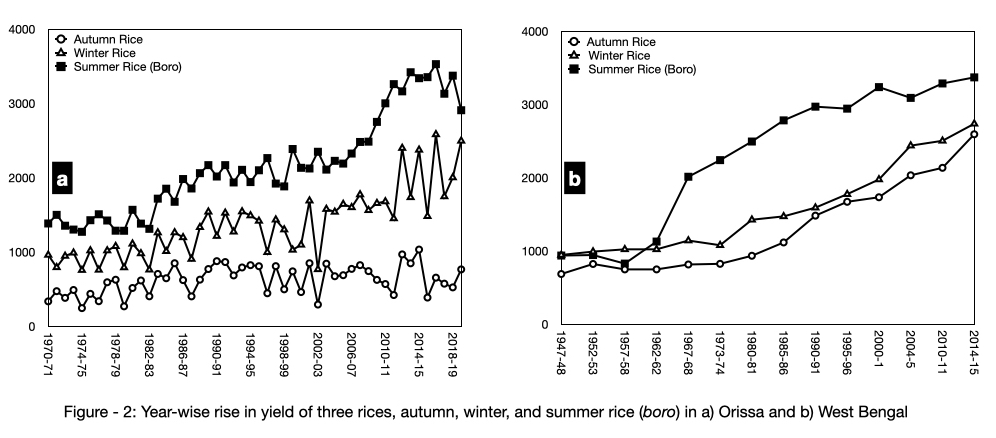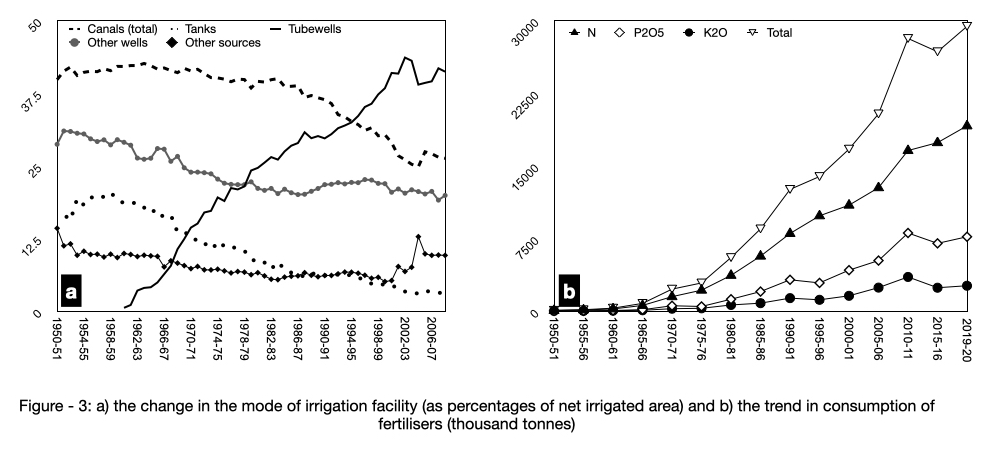Love (or hate?) triangle – Boro rice, groundwater, and the environment
No water, no agriculture!
The tryst of the endeavour of growing food with water is deep-seated and commenced with the early dawn of agriculture. However, the magnitude of dependence underwent a remarkable change in the last half-century or more. In the South Asian context, farmers used to rely on the summer monsoon for their crops. Additional sources like smaller to bigger dams, perennial water bodies, streams, canals, and rivulets supplied much-needed water to the agri-fields. Water requirements also vary widely with crops, for example, pulses can withstand shallow water conditions whereas a modern rice farmer rice could be horrified by crop failure in the same limiting conditions.
Had it been the same throughout the history of rice cultivation?
In contrast to wet rice or rice paddy, which grows in stagnated water at the base, rice has been cultivated for centuries or even millennia in widely diverse agroecosystems from fertile riverbanks, lowlands, foothills, to hilly slopes, terraces, or shifting cultivation fields (figure – 1). The divergent environmental conditions of various rice agroecosystems unleashed huge variation and as a result, numerous landraces or heirloom varieties evolved over centuries through farmers’ selection. These landraces were, loosely said, ‘tailor-made’ for each rice agroecosystem and were interwoven into the social-cultural and economic life of peasants and other rice-eating communities (Ray et al. 2013).

Today, rice is the lifeline of South Asia covering about one-fourth of the total cropped area
Today, rice is the lifeline of South Asia covering about one-fourth of the total cropped area and providing food to about half of the Indian population. It is cultivated in about 44 million ha with production and productivity of 112.76 million tonnes and 2.576 tonnes/hectare, respectively. It was historically grown in two to three overlapping seasons in and around the vast swathes of the subcontinent depending on the local agroecologies. The aus, ahu, bhadai, zaid, or autumn rice, and Kharif, winter, or aman rice, have been cultivated from March-April to September, June-July to November-December, respectively. Winter or Kharif rice, the primary rice crop grown abundantly throughout the country, received water from profuse monsoon showers.
In contrast, boro rice has been traditionally grown from November-December to May-June in the deeply flooded lowland areas of West Bengal, North-East Bihar, Eastern Uttar Pradesh, Assam, and neighboring Bangladesh. The rationale was to make use of and harvest crop from the fertile river basins, deltas, chaurs, or saucer-shaped depressions, where water accumulates during the monsoons but cannot be drained, thus providing ideal settings for boro rice cultivation during the winter season. It was productive owing to the availability of good sunshine during the growing season, less risk of crop failure, highly fertile soil, and less incidence of insect pests and diseases due to the cool and dry season. The soil moisture retained from the flood water and residues from preceding Kharif rice facilitated the growth of the boro rice. Century-old historical accounts are replete with the rice culture of the subcontinent that capitalized on the use of the local prudence of the farmers, i.e., traditional agroecological wisdom to cultivate rice or other crops complementing the local agro-ecological conditions of soil, temperature, water, rainfall, and finally labor.
The late sixties and early seventies encountered a sea change in Indian agriculture. The technological package of the Green Revolution (henceforth GR) arguably revolutionized agrarian activities in the subcontinent and elsewhere. With the sure supply of HYV seeds, shallow pump lifting groundwater, subsidized (nitrogenous) fertilizers, and standard procurement systems through minimum support price guarantee, the Green Revolution was promoted with little consideration of local socio-economic or ecological conditions. It caused an unprecedented rise in production and yield and has set in motion the long-awaited economic growth of many states. Especially for the principal cereal crop, rice as well as wheat, which have demonstrated a spurt in production and yield. Self-sufficiency in rice and wheat has undoubtedly abolished the fangs of impending hunger but social, cultural, and ecological costs are mounting.
In many places, the success of the GR especially rode on the dry-season boro rice cultivation and it was the powerhouse of agricultural growth, e.g., in the eastern parts of India. Here, boro yield skyrocketed and reached almost two-three times the pre-Green revolution era (figure – 2). Compared to 2-3 t/ha of traditional boro varieties the newly developed varieties can produce as high as 5-7 t/ha. With proper crop management, yield levels can reach up to 10-12 t/ha with suitable high-yielding varieties and hybrids (Bhakta et 2021).

High productivity thus higher profit is the primary factor underlying farmers’ choice and its wider acceptance. In other regions, boro rice has become very popular for its higher-yielding ability than Kharif rice in the same ecology. In fact, the yields recorded from the experiments, both at the research stations and at farmers’ fields show that yields from boro rice are several times higher than that of Kharif rice. With the introduction of short-duration, cold-tolerant modern varieties and hybrids, it started rolling even faster. At the outset, high-yielding short- (Pusa 2-21, Pusa 33, and Saket 4) and medium-duration (Sita, Sujata, Jaya, and IR 36) semi-dwarf varieties for Kharif season were introduced and tested in the boro season. However, none was found to be suitable for cultivation as boro. Gautam was the first boro variety released for cultivation in 1994 and it was followed by the release of a number of boro rice varieties like Chandrama, Dhanlaxmi, Jaymati, Jyotiprasad, Richharia, TRC Boro Dhan.
It was supplemented with the creation of micro-irrigation facilities through shallow tube wells and subsidized nitrogenous fertilizers. Provisioned with a sure supply of irrigation water as and when needed and nitrogenous fertilizers facilitated to achieve the higher yield of boro rice. The cultivation of boro rice has been fast spreading to non-traditional areas in eastern India, sometimes usurping the acreage held by autumn rice, pulses, or oilseeds. The process of technology diffusion and acceptance continued as shown by the persistent rise in the acreage of boro rice.
Well! Everything looks fine and great up to this.
The story is simple and linear, farmers would embrace the crops that’d offer them more in terms of economic return. They might even abandon other crops to sow the crop giving assured profit. But the problem lies elsewhere.
While the economic gain of boro has been high the environmental and socio-ecological damage when examined through a different lens looked scary. Let us indulge in two aspects incurred by widescale adoption and propagation of boro cultivation especially in terms of groundwater consumption and agrochemicals (Ray and Ghosh 2007; Ray 2022).
Boro rice has caused a shift in cropping patterns. For example, the increment of water-thirsty boro crop acreage replaced water-thrifty aus (mostly grown in upland conditions and drier months) and changed the water use landscape in rice agriculture in West Bengal and elsewhere. Since, boro rice, is a water-guzzling HYV crop, whose high productivity can only be sustained with a high dosage of fertilizers, a huge volume of water, and other supplements. The gradual shift from aus to HYV boro made it essentially groundwater-dependent. There were simultaneous developments in the irrigation facility.
Wells emerged as the primary source of irrigation which was dependent on canals and tanks in the pre-GR era. Tanks for water conservation and use have become almost obsolete. Wells, unlike canals and tanks, ensured easy and predictable supply to groundwater which is likely the reason for high productivity (Ray 2022). The scenario of groundwater extraction through deep tube wells has been a common trend throughout the country (figure – 3a) that greatly endangers water sustainability. Groundwater has often been lifted at a rate without allowing further recharging that is used to lower the groundwater levels and affected availability for other purposes (e.g., drinking). It further intensifies the public health hazard through arsenic contamination in the water causing safe drinking water unavailable (Ray and Ghosh 2007). Data says that nearly 60% of Indian districts are facing an acute problem of groundwater over-extraction or severe contamination with arsenic, fluoride, mercury, and manganese.

The other issue that was operative in tandem was the unregulated and overuse of agrochemicals. Because the semidwarf varieties were engineered to respond well to nitrogenous fertilizers, their application has been made indispensable (Khush 2001). The net outcome was a steady spurt in consumption (figure – 3b). Besides, the new varieties frequently succumbed to recurrent pest attacks and warranted heavy pesticide application. Altogether, the increasing levels of nitrate or other agrochemical pollutants in groundwater have serious health implications (Shah et 2021). There was another important setback, heavily contaminated water threatened the biodiversity of rice field agroecosystems and contiguous water bodies. In the process, it accelerated the depletion of the edible biota of agricultural fields which was a part of the food culture of many rice communities of South and Southeast Asia (Ray and Chakraborty 2021). In a nutshell, the ghosts of the Green Revolution still loom large on our food systems!
The clear signal from the studies reveals that the socio-ecological systems are closely knitted through numerous networks, perturbations at one node of the network could generate ripples across and be felt at one or multiple nodes. Therefore, science and technology-meditated developmental interventions should not be short-sighted manipulations hinging on a limited set of economic objectives but also be inclusive of ecological, cultural, as well as social repercussions.
About the author:
 Avik Ray is a researcher, educator, consultant, and communicator of science. He is interested in environmental history, political ecology, and anthropology of food gathering and production, and biocultural diversity of food, and strives to unravel their implication on sustainable agriculture, rural livelihood, food security, and climate change. ResearchGate Profile, Web
Avik Ray is a researcher, educator, consultant, and communicator of science. He is interested in environmental history, political ecology, and anthropology of food gathering and production, and biocultural diversity of food, and strives to unravel their implication on sustainable agriculture, rural livelihood, food security, and climate change. ResearchGate Profile, Web
References:
Bhakta N, Choudhary AK, Kumar S, Mishra, JS, Monobrullah Md and Kumar U. 2021. Improved Production Technology for Boro Rice Cultivation in Eastern India. Technical Bulletin, R-69/Patna-39, ICAR-Research Complex for Eastern Region, Patna, India.
Khush GS. 2001. Green revolution: the way forward. Nature Reviews Genetics 2(10):815-22. https://doi.org/10.1038/35093585
Ray A, Deb D, Ray R, Chattopadhayay B. 2013. Phenotypic characters of rice landraces reveal independent lineages of short-grain aromatic indica rice. AOB plants. 2013 Jan 1;5:plt032. https://doi.org/10.1093/aobpla/plt032
Ray S and Ghosh D. 2007. Modern agriculture and the ecologically handicapped: fading glory of boro paddy cultivation in West Bengal. Economic and Political Weekly. (2007) 2534–2542.
Ray A. 2022. The darker side of agricultural intensification-disappearance of autumn or aus rice, entry of HYVs, and implications in terms of environmental sustainability in a ‘Green Revolution’ state of eastern India. World Development Sustainability. 2022 Jan 1;1:100028. https://doi.org/10.1016/j.wds.2022.100028
Ray A and Chakraborty A. 2021. The edible biota in irrigated, deepwater, and rainfed rice fields of Asia: a neglected treasure for sustainable food system. Environment, Development, and Sustainability 23(12):17163-79. https://doi.org/10.1007/s10668-021-01386-0
Shah M, Vijayshankar PS and Harris F. 2021. Water and agricultural transformation in India: A symbiotic relationship-I. Economic and Political Weekly 56(29):43-55.

